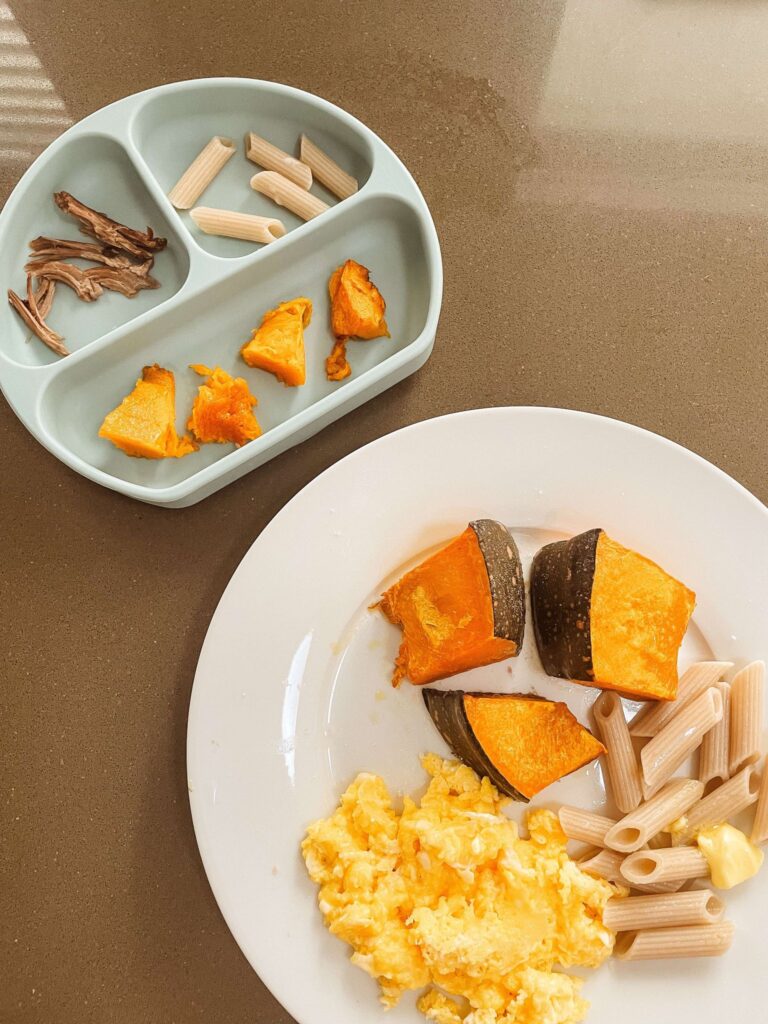There are different ways you can start your baby on solid foods. As a Holistic Nutrition Consultant for Babies and after having four children, I will share below why I think baby led weaning is best to start.

There are a few ways you can begin your baby on solid foods.
The first way is by offering pureed foods and spoon feeding your baby.
The second way is by baby led weaning, which means you are offering your baby appropriate and safely served food for your baby to feed themself.
The third is by doing a combination of pureed foods and baby led weaning depending on the food.
With my first two babies, I did a combination of both pureed foods and baby led weaning. This was mainly because it was convenient and limited the mess. However, if I did my time over with my two eldest babies, I would have introduce food via solely baby led weaning.
I baby led weaned my third baby, and I much preferred this way of introducing food, as did he, due to the reasons I will mention below.
There is absolutely no right or wrong way of introducing solid food to your baby. You need to feel comfortable with your feeding method and it should match your lifestyle.
However, there is a lot of fear around baby led weaning, due to the possibility of babies choking and the mess.
The goal of this post is to ease your fears around baby led weaning and encourage you to give it a try!
What I’ll cover in this post
- Guidelines about when to start your baby on solids
- Safe ways to introduce food to your baby
- Why I think baby led weaning is best

Guidelines about when to start your baby on solids
Many parents prematurely begin their baby on solids for different reasons. It could be that your baby is showing signs of readiness by looking intently at food, or your baby is waking up frequently during the night, indicating hunger. Or there is pressure from family and friends to start your baby on solids.
Previous studies supported the idea that babies should start solids at 4 months old. Here is why that is too early an age to start:
The National Health and Medical Research Council recommends that babies are exclusively breast fed/bottle fed until 6 months of age and begin on solids at around 6 months of age (source).
This is due to a baby’s digestive system not being developmentally ready, and has not yet developed the tongue-thrust reflex (which protects babies from choking, helping them to get food out of their mouth quickly and safely) and the risk of increasing allergies and infections.
By the age of 6 months, your baby should be able to sit up, have developed her pincer grasp, has lost her tongue-thrust reflex, can turn her head to indicate that she is full and is likely eager to participate in meal times (of course, this does not apply to all babies, but most).
This is why it is ideal to wait until your baby is 6 months of age to start eating solids.
Read more about first foods to introduce to your baby in another one of my blog posts.
More on the blog
15 ideal gifts for a new mother
How to overcome picky eating in toddlers
Foods to avoid feeding your baby in the first year
Safe ways to introduce food to your baby
If you are considering baby led weaning for your baby, you must ensure you are serving your baby appropriate sized, shaped and textured food.
Here is a guideline to follow:
Size and shape: foods should be served in stick shapes and long enough for a baby to hold and sticking out for them to bite.
Texture: foods should be soft enough to squish between the tongue and roof of mouth.
Hard fruits and vegetables: foods like apples and carrots should be steamed or baked soft, until baby is comfortable chewing. The skin of produce should be peeled off before feeding.
Softer fruits and vegetables: can be offered raw (e.g. inner cucumber and the inside of a watermelon without the skin). Ripe/soft fruits can be offered to baby as wedges or stick shapes without the peel.
Small round foods: small round foods should not be offered to babies until they can safely chew and maneuver these types of foods in their mouth. Therefore, when introducing solid food, keep to stick shaped or wedge shaped foods.
Stringy foods: stringy foods like green beans and celery should not be offered to baby until they are old enough to safely chew and maneuver these types of foods in their mouth.
Stone fruit and pits: If offering a stone fruit, ensure that you remove the pit/stone prior to serving, as babies can choke on these.
Why I think baby led weaning is best
If you can’t tell already, I am a big advocate for baby led weaning. And if you are not yet convinced it is safe or appropriate for your feeding method, then let me encourage you here.
If you intend to spoon feed your baby, then consider the following:
- Ensure that your purees include healthy fats and proteins (coconut oil, butter, peanut butter, meat, lentils etc. at the appropriate age of introduction).
- Ensure that your baby is in control of their meal (i.e. don’t force them to eat if they are showing signs that they are full).
- Ensure that you are making most, if not all of the purees from scratch. If you intend to feed via purees, it can be tempting to buy the store bought purees. However, these contain high levels of sugar and they are stripped of much of their nutrition value due to manufacturing). So, homemade purees are always ideal for nutritional content.
Now, onto baby led weaning. Here is why I’m a huge advocate:
- It allows your baby to be in control: you offer your baby the food, they have the choice to eat it or not. This gives them autonomy and sets them up for a healthy relationship with food as they grow older.
- Your baby gets to explore: rather than eating puree food, where the texture often remains the same, your baby gets to explore different textures, flavours and colours, which makes for a lot of fun.
- Your baby eats the same meal as you: often when you serve pureed foods, you are offering a different meal to your baby than the rest of the family is having. Baby led weaning allows your baby to eat the same food as everyone else (so it’s less preparation for you and a more connected family experience).
- It helps to improve manual dexterity: finger foods at an early age can help the baby to improve their hand eye coordination. As much as it is tempting to help your baby get food into their mouth, try to refrain and allow them to learn this skill for themself.
- Helps to encourage a diversity of eating as baby gets older: I’m not sure if this is backed up by research, but I know from many of my friends who have served pureed food compared to BLW with their children, and they often say that the babies that were BLW, are better eaters now, as they have gotten older., compared to their babies that were spoon-fed.. This may or may not be true for all children, but is worth mentioning here.
I’m not suggesting that this is the right method for every family. You as the parent need to be comfortable with this method of feeding and your partner needs to be on board with it also.
However, the positives of baby led weaning outweigh the negatives, in my opinion.
I’d love to know what you think! If you haven’t started your baby on solids yet, will you give BLW a go?
Leave a Reply